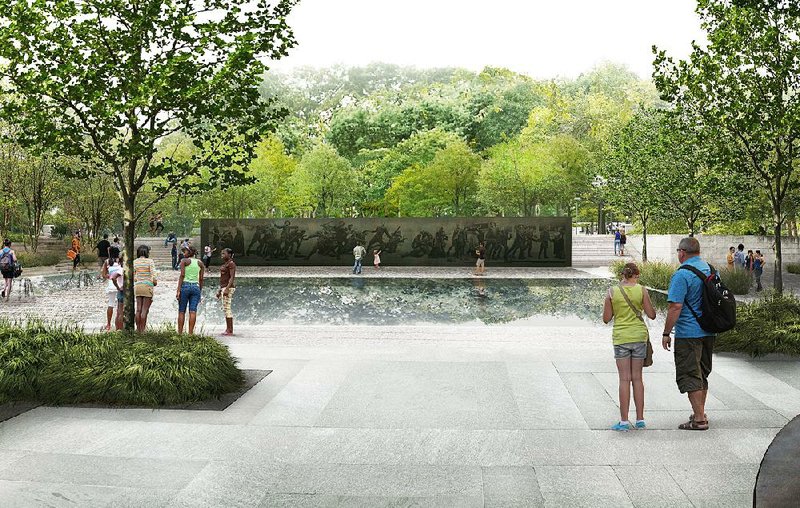WASHINGTON -- Backers of a new World War I memorial are eager to break ground, but first they have to consult with a number of federal bodies and comply with a thick stack of government rules and regulations.
The various councils and commissions can advance, delay or derail a design.
Joseph Weishaar, the University of Arkansas, Fayetteville graduate who created the winning proposal, said he attends a lot of meetings and doesn't mind doing so.
"It's part of the process," he said after his most recent public hearing.
In May, the World War I Centennial Commission took its latest proposal to the Commission of Fine Arts, which approved the updated design concept.
In June, Weishaar and others met with the Advisory Council on Historic Preservation, which reviewed the proposal for more than 90 minutes.
This Thursday, they're scheduled to appear before the National Capital Planning Commission, which must sign off on the project before it can advance.
The memorial is to be built on a prime piece of real estate, just down the street from the White House.
A 2014 law selected the site and authorized the World War I organization to place "appropriate sculptural and other commemorative elements" there.
Weishaar isn't the only Arkansan who is shaping the memorial. Phoebe Lickwar, a professor at UA's Fay Jones School of Architecture, is the project's landscape architect. A New York City sculptor, Sabin Howard, will create the commemorative wall.
Because the 1.76-acre parcel is part of the Pennsylvania Avenue National Historic Site, any changes would automatically be carefully scrutinized.
But the proposal is drawing extra attention because it will be placed in Pershing Park, which is eligible, on its own, for listing on the National Register of Historic Places.
Designed by M. Paul Friedberg and subsequently modified by the Oehme-Van Sweden landscape architecture firm, the existing park has national significance, according to the District of Columbia State Historic Preservation Office. The park, the office determined, is "an exceptional example of a landscape design of the modern period and of an approach to the design of public space as an integral part of the revitalization of an urban neighborhood in decline."
Since then, efforts have been made to avoid or mitigate potential adverse effects on the site.
Rather than dramatically changing the existing site, Weishaar has scaled back his plans, incorporating large portions of the existing design.
The pool, originally planned for removal, has been kept. The bas relief wall has been scaled back, from 80 feet to 65 feet.
A statue of John J. Pershing, the general of the armies during World War I, will continue to occupy a place of honor: Weishaar's original design also retained it.
"At this point, really, we're trying to see how much we can get out of modifying what's there rather than adding to it or adding new things," he said. "We start adding new things, and people want to kind of flick them off."
At the meetings, people weigh in, sometimes sharply criticizing the effort.
At last month's session, Cultural Landscape Foundation President Charles Birnbaum warned that the latest design would have an adverse effect on the "visual and spacial connectivity between the upper and lower terrace and plaza," significantly altering the existing park.
A report, prepared for the advisory council, said that modifications to the existing pool, removal of granite planters and the elimination of a kiosk would all have an "adverse effect" on the existing park.
Darwina Neal, a former National Park Service cultural resources preservation official, said elimination of a cascading water feature would be harmful, a point Birnbaum also stressed.
The pool and the falling water are inextricably linked, she said.
"Because they're so significant, they're really the heart, the heart of the whole park," she added.
In addition to the big issues, smaller details were also addressed.
Neal even inquired about the waste receptacles and the drinking fountains.
Weishaar listened carefully as people spoke, keeping track of their concerns.
When there's a public hearing, "we always know that it's going to be kind of a rough day," Weishaar said afterward. "But it's really great for us because it gives us a direct line of communication between the public and [we] hear what they think and what they want."
The comments and suggestions aren't ignored.
The design has evolved over the past 17 months in response to the feedback from board members and other citizens. Once the changes are made, members of the design team return and present their revised proposal.
"The key thing to take away from all these meetings is that every time we have one, it means that we've made it to the next step. We can ask the next set of questions and share what we've been working on again," Weishaar said.
None of the obstacles have proved insurmountable thus far.
"Overall, I'm feeling good about it," Weishaar said.
Although the reviews take time, they're necessary, according to Chris Wilson, a program analyst with the Advisory Council on Historic Preservation.
"This park will be here for 100 [or] 150 years. Maybe forever. So it's important," Wilson said.
Given the 2014 law, changes at the park are inevitable, according to Tom Luebke, secretary of the Commission of Fine Arts.
"We expect that there is going to be an adverse effect on [the] historical design from the get-go," he told critics at last month's meeting. "So we're going to have to figure out what's tolerable or not."
SundayMonday on 07/10/2017

